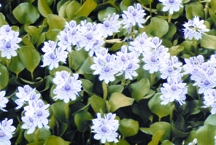Water Hyacinth
Water Hyacinth (kachuripana) a tropical, floating luxurious aquatic plant, Eichornia crassipes, of Latin American origin; grows prolifically, and often hinders the passage of boats by blanketing the surface of the water. The plant is a free-floating herb that sends down a large bunch of long fibrous roots from a leafy main stem. The petiole of the leaf is short and spongy. The leaf blade is broadly ovate or rhomboid, and is broadly obtuse at the apex.

Inflorescence is peduncled, about 15-20 cm, having 10-20 showy flowers. In Bangladesh the plant is familiar as a noxious weed and grows in almost all stagnant waterbodies. During the monsoon it multiplies rapidly and spreads quickly in newly inundated flood lands. It flowers during October-January.
It is said that a tourist, attracted by the orchid-like flower of the water hyacinth, introduced it to Bengal from Brazil sometime in the latter part of the 19th century. Its rank growth proved to be so fast and monstrous that by the 1920s all the waterbodies of Bengal had become clotted with this aquatic plant. River navigation was obstructed, cultivation of wetland crops including deepwater aman paddy and jute, became difficult, and consequently the economy of Bengal showed marks of stagnation.
Under the circumstances, the relevant laws of the government, such as the Bengal Waterways Act, Bengal Municipal Act, Bengal Local Self-government Act and Bengal Village Self-government Act, were geared up to fight the scourge, but to little effect. Finally, the government decided to eradicate the water hyacinth by organised voluntary labour. The Water-hyacinth Act (1936) was enacted prohibiting all householders from keeping or tolerating water hyacinth on their holdings and premises and making cooperation with government sponsored clearing drives a public duty. District collectors of affected zones were directed to organise water-hyacinth destruction programmes and make such programmes a success mainly with voluntary labour.
The publicly sponsored clearance drives received an enthusiastic response from the people. Election (1937) manifestos of all major political parties promised to eradicate the water hyacinth. The eradication drive was further intensified after elected representatives assumed power in 1937 under the leadership of AK Fazlul Huq.
There are some additional reasons for the success of the water-hyacinth eradication programme. Heaps of water hyacinth, when decayed, make wonderful fertiliser for cropping. Moreover, some crops and vegetables grew luxuriously on the dressed water hyacinth heaps. This has attracted many landless peasants to accumulate and heap water hyacinth to make floating fields for agricultural production.
By 1947 the scourge of the water hyacinth came under control and in the next decade the rivers of East Bengal became more or less navigable again. Water hyacinth still exists in many parts of Bangladesh, particularly in the haors and beels, but these do not pose any serious problem to navigation or to cultivation any more. The plant is chiefly used as manure; the leaf is used as fodder in floodplains when fodder is scarce. [Mostafa Kamal Pasha]
See also weed; flora; aquatic plant.
